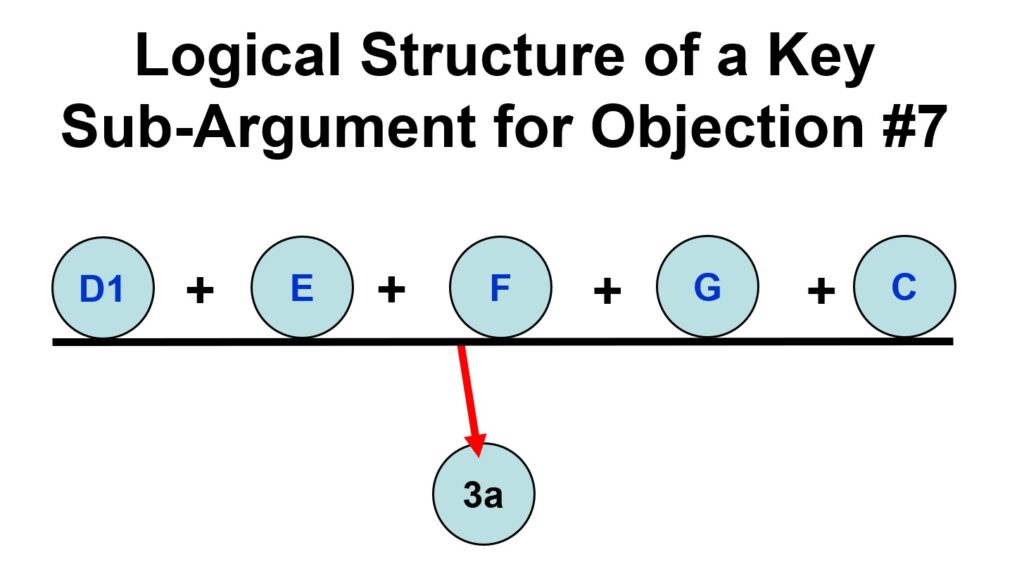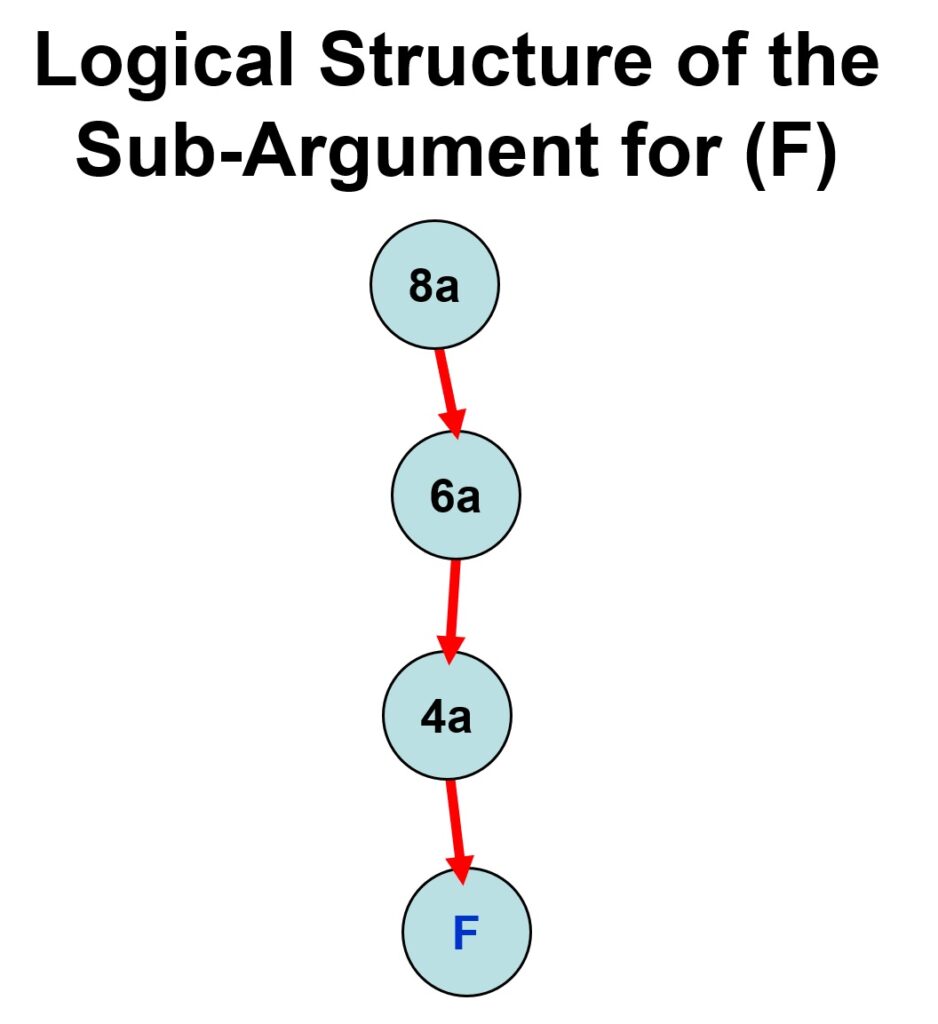Kreeft’s Case Against the Swoon Theory – Part 28: The Sub-Argument for Premise (F)
WHERE WE ARE
Premise (3a) is a key premise in the core argument of Objection #7 (Who Moved the Stone?) against the Swoon Theory. Here is the argument supporting premise (3a):

D1. Jesus did NOT move the stone from the door of Jesus’ tomb on the weekend after Jesus was crucified (unless Jesus experienced a supernatural resurrection).
E. The Roman soldiers did NOT move the stone from the door of Jesus’ tomb on the weekend after Jesus was crucified.
F. The Jewish authorities in Jerusalem did NOT move the stone from the door of Jesus’ tomb on the weekend after Jesus was crucified.
G. It is NOT the case that some or all of Jesus’ eleven remaining disciples moved the stone from the door of Jesus’ tomb on the weekend after Jesus was crucified.
C. There are only four possible natural explanations for how the stone was moved from the door of Jesus’ tomb on the weekend after Jesus was crucified: (a) Jesus moved the stone, (b) the Roman soldiers moved the stone, (c) the Jewish authorities in Jerusalem moved the stone, or (d) some (or all) of Jesus’ remaining eleven disciples moved the stone.
THEREFORE:
3a. There is no plausible natural explanation for how the stone was moved from the door of Jesus’ tomb on the weekend after Jesus was crucified.
There are a number of serious problems with this argument for the key premise (3a).
In Part 25 of this series, I showed that premise (C) in the sub-argument for the key premise (3a) is FALSE. Thus, the argument for (3a) is UNSOUND and should be rejected. Thus, premise (3a) is DUBIOUS and might well be FALSE. Therefore, the core argument of Objection #7 (Who Moved the Stone?) should be rejected, and Objection #7 against the Swoon Theory FAILS.
In Part 26 of this series, I showed that premise (D1) in the sub-argument for the key premise (3a) is DUBIOUS. Therefore, premise (3a) is DUBIOUS and might well be FALSE. Therefore, the core argument of Objection #7 (Who Moved the Stone?) should be rejected, and Objection #7 against the Swoon Theory FAILS.
In Part 27 of this series, I showed that premise (E) in the sub-argument for the key premise (3a) is DUBIOUS. Therefore, premise (3a) is DUBIOUS and might well be FALSE. Therefore, the core argument of Objection #7 (Who Moved the Stone?) should be rejected, and Objection #7 against the Swoon Theory FAILS.
In this current post, I will argue that premise (F) in the sub-argument for the key premise (3a) is DUBIOUS. Premise (3a) is therefore DUBIOUS and might well be FALSE.
THE SUB-ARGUMENT FOR PREMISE (F)

8a. The Jewish authorities in Jerusalem had the stone put in place at the door of Jesus’ tomb in the first place.
THEREFORE:
6a. It was in the interest of the Jewish authorities in Jerusalem to keep the tomb of Jesus sealed on the weekend after Jesus was crucified.
THEREFORE:
4a. The Jewish authorities in Jerusalem would NOT have moved the stone from the door of Jesus’ tomb on the weekend after Jesus was crucified.
THEREFORE:
F. The Jewish authorities in Jerusalem did NOT move the stone from the door of Jesus’ tomb on the weekend after Jesus was crucified.
EVALUATION OF THE SUB-ARGUMENT FOR PREMISE (F)
The sub-argument for premise (F) is based on this historical claim:
8a. The Jewish authorities in Jerusalem had the stone put in place at the door of Jesus’ tomb in the first place.
Premise (8a) is probably FALSE, so the sub-argument for premise (F) is probably UNSOUND and should be rejected, and since premise (F) is NOT obviously true, that means premise (F) is DUBIOUS and might well be FALSE.
Premise (8a) is probably FALSE for a couple of reasons. First, the stone was already in place on Friday evening, according to all four Gospels. The Jewish authorities in Jerusalem did not request to have the tomb guarded by soldiers until Saturday (see Matthew 27:62-66).
Second, and more importantly, the story about the Jewish authorities being concerned about the security of the tomb of Jesus is found ONLY in the Gospel of Matthew and is part of the story about Roman soldiers being assigned to guard the tomb of Jesus, a story which is probably an apologetic legend. So, the historical claim made by premise (8a) is probably FALSE.
Premise (6a) is inferred from premise (8a):
8a. The Jewish authorities in Jerusalem had the stone put in place at the door of Jesus’ tomb in the first place.
THEREFORE:
6a. It was in the interest of the Jewish authorities in Jerusalem to keep the tomb of Jesus sealed on the weekend after Jesus was crucified.
This is not a formally VALID inference. However, does (8a) imply (6a) or provide powerful evidence for (6a)? I don’t think so. There is an unstated assumption operative in this inference:
Whatever the Jewish authorities in Jerusalem decided to do was based on what they believed to be in their interest.
But this assumption is not sufficient by itself to justify the inference of (6a). Another assumption is needed:
Whatever the Jewish authorities in Jerusalem believed to be in their interest was in fact in their interest.
The first assumption seems very plausible even probable, although not certain. The second assumption is less plausible even somewhat improbable. People often fail to accurately assess what is in their best interest, even when they make a serious effort to determine what is in their best interest. Because these two additional assumptions are required to make the inference from (8a) to (6a) logical, this inference is DUBIOUS. Even if we assume for the sake of argument that (8a) is TRUE, premise (6a) would still have a significant chance of being FALSE. So, the inference from (8a) to (6a) is DUBIOUS, meaning that (6a) is itself a DUBIOUS claim.
Premise (4a) is then inferred from premise (6a):
6a. It was in the interest of the Jewish authorities in Jerusalem to keep the tomb of Jesus sealed on the weekend after Jesus was crucified.
THEREFORE:
4a. The Jewish authorities in Jerusalem would NOT have moved the stone from the door of Jesus’ tomb on the weekend after Jesus was crucified.
This is not a formally VALID inference. However, does (6a) imply (4a) or provide powerful evidence for (4a)? I don’t think so. There is an unstated assumption operative in this inference:
Whatever was in fact in the interest of the Jewish authorities in Jerusalem was believed by them to be in their interest.
As I stated above, people often fail to accurately assess what is in their best interest, even when they make a serious effort to determine what is in their best interest. Thus, the inference from (6a) to (4a) is DUBIOUS. Even if (6a) was TRUE, there would still be a significant chance that (4a) was FALSE.
CONCLUSION ABOUT THE PREMISE (F)
Here are my conclusions about the sub-argument for premise (F):
- Premise (8a) is probably FALSE.
- The inference from (8a) to (6a) is DUBIOUS.
- The inference from (6a) to (4a) is DUBIOUS.
The cumulative impact of these three problems is sufficient to show that premise (4a) is DUBIOUS. Since (4a) is the reason given to support premise (F), and since premise (F) is NOT obviously true, it is reasonable to conclude that premise (F) is itself DUBIOUS.
Because (F) is one of the premises in the sub-argument for the key premise (3a), we have yet another good reason to reject the sub-argument for the key premise (3a) and to doubt the truth of (3a). Because premise (3a) is a key premise in the core argument of Objection #7, and because (3a) is DUBIOUS, we should reject the core argument of Objection #7. Therefore, Objection #7 (Who Moved the Stone?) against the Swoon Theory FAILS.
